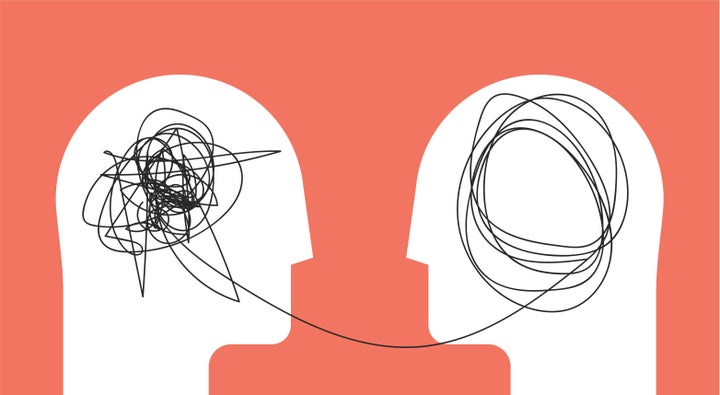
Trauma doesn’t always look the same. Whether it’s a failed relationship, an unspeakable act of violence or a devastating natural disaster, traumas differ in their severity, as well as their effects on us.
If you’ve ever experienced it, you know how difficult it can be to imagine living a normal life where you’re not regularly reminded of what you experienced. But one therapy treatment promises it can help with some erasure.
It’s called eye movement desensitization and reprocessing, or EMDR. The therapy type is supported by research, and considered as an effective treatment for trauma by a host of international organizations, including the American Psychiatric Association, the Department of Veterans Affairs, and the World Health Organization.
The origins of EMDR date back to 1989, when psychologist Francine Shapiro realized that rapid eye movements helped assuage her own negative emotions while walking through a park. Shapiro spent years developing, practicing and studying the effects of the therapeutic procedure, eventually coining the name EMDR in 1991.
How does EMDR work?
When we go through a traumatic event, our central nervous system kicks into high gear, reacting with an applicable stress response — i.e., a fight, flight or freeze reaction. Sometimes a distressing event can be processed sufficiently by our brain on its own, and it heals itself.
But other times, our brain can get “stuck” in the past and continues to react as if we’re still experiencing the disturbing event — as if we’re back in the trauma, explained Charlotte Margulies, a psychotherapist and founder of Aspen Alliance Counseling. That’s where EMDR can help. Through enabling the differing parts of the brain to communicate more effectively, EMDR helps our brain process traumatic memories more effectively.
In EMDR, “the traumatic memory becomes part of the existing positive memory network, which brings relief to the patient,” said Sandra McCluskey, assistant professor of psychiatry at The University of Toledo and a licensed professional clinical counselor. “The patient can still recall the memory, but because it is finally properly stored with existing adaptive and positive memories, the patient no longer emotionally reacts when they think about it.”
EMDR therapy consists of eight different phases. Phase 1 involves history-taking, where the therapist learns more about the client’s past and develops a treatment plan. In Phase 2, the therapist spends time teaching the client coping and calming skills to help them handle emotional distress, which they can use between and during sessions. The amount of time spent in these phases is determined on a case-by-case basis, McCluskey said, and depends on the patient’s history, their specific traumas and the judgment of the therapist.
During Phases 3 through 6, the client will target and reprocess — or work through — the identified trauma. This is where the signature modality of EMDR comes into play, known as bilateral stimulation (BLS). The three types of BLS to stimulate eye movement include: visual (when a therapist moves a finger or light bar back and forth), auditory (slight chimes or other sounds that alternate in each ear), or tactile (buzzers that you hold in your hand and pulse back and forth).
While engaging in BLS, the client will be instructed to focus on a visual image of the trauma, a negative thought they associate with themselves and bodily sensations.
After the eye movement stimulations, the client is instructed to simply notice whatever thought, feeling, image, memory or sensation comes to mind. Again, these phases will last as long as needed for the client to eventually eliminate feelings of distress associated with the trauma.
Finally, Phases 7 and 8 wrap up the therapeutic sessions. The therapist makes sure the client feels stable and safe moving forward, knowing how to use the self-regulating techniques learned in Phase 2, and evaluates the progress the patient has made.
In order to offer EMDR therapy, mental health professionals must go through EMDR training.

Who is EMDR for?
EMDR is continually emerging as a useful form of treatment for people who have suffered traumatic events, and almost anyone may benefit from EMDR therapy (more on that below).
EMDR is applicable to a range of traumas, such as sexual assault, a car accident, violent crime, bullying as a child and breakups, Margulies explained. Anyone who’s been in talk therapy for a while and not seeing the results they are hoping for might want to give EMDR a try.
Research backs up the effectiveness of EMDR. One notable study found that 12 sessions of EMDR eliminated PTSD in over 77% of combat veterans who participated in the research. Another study found that 100% of the single-trauma victims and 77% of multiple trauma victims no longer were diagnosed with PTSD after only six 50-minute sessions.
And while EMDR might be most studied for its effects on traumatic memories, it may also work for a myriad of other mental health issues, according to both research and anecdotal stories.
“I’ve had so much success using EMDR therapy for so many different issues,” McCluskey said. She’s used it to help patients work through unresolved grief, anxiety and panic attacks.
Donna Brown, an author and retired registered nurse in Pearce, Arizona, said EDMR helped her to manage her trauma symptoms ― including intense depression, anxiety and suicidal thoughts ― that stemmed from childhood abuse.
“As I sat in front of the machine week after week watching the flashing lights, I wondered if there was any validity to the treatment,” Brown, 68, said. “Nonetheless, as time went on, I began to experience noticeable improvement in my mood and a steady decline in the number of flashbacks.”
After a year of therapy, Brown said she stopped getting horrific flashbacks.
“I was able to live a normal life without fear of recurrence,” she said. “Through my experience of EMDR, I gained invaluable knowledge about this procedure and sense of gratitude to be alive and enjoying life. Perhaps EMDR will not work in all situations, yet I would highly recommend it to others who are struggling with their own mental health challenges.”
Are there any drawbacks to EMDR?
Brown is right that EDMR isn’t a cure-all for everyone. Overall, mental health professionals seem to be in agreement that EMDR is an effective and safe way to help people process traumatic memories. However, there are some cons, said Shirley Porter, a psychotherapist and writer for Choosing Therapy, who has experience with EMDR as both a patient and a professional.
For some people, EMDR is just not a fit, Porter explained. One of the challenges: “Since the therapy itself causes a client to relive the trauma for brief periods of time, some find it too painful to get to a point where the memories of the trauma cause no distress at all,” she said.
Another reason someone may not want to proceed with EMDR is related to the emotional dysregulation some may experience following an EMDR session. This can manifest as an inability to calm down or manage one’s own emotions, as well as a spike in PTSD symptoms, such as flashbacks or nightmares.
This is why the timing of EMDR sessions is so important, Porter emphasized. “It’s not something one would want to do the week prior to an exam, job interview or major presentation, due to the potential distress that could occur.”
Just like any therapy modality, every individual will respond differently to EMDR. But as Margulies noted, most of the feedback she receives as a therapist from patients going through EMDR is positive.
“Most people tell me that they enjoy it not only because it’s effective, but it also feels safe,” she said. “And the biggest gift that it gives people that can be hard to find elsewhere is a sense of relief that they’re making progress.”
This story has been updated to more clearly reflect information on therapists’ training in EDMR.